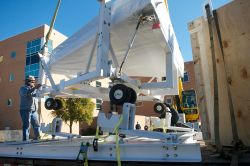ODU Delivers First of Sophisticated Detector Components to JLAB
February 12, 2012

A couple of years from now, when the $310 million energy upgrade at the Thomas Jefferson National Accelerator Facility in Newport News is completed and atom smashing experiments begin to probe deeper into the building blocks of matter, physicists at Old Dominion University will look back on Feb. 13, 2012, as a red-letter day.
That is because on Monday ODU shipped off to JLab the first of five wedge-shaped contraptions university scientists are building to form a giant detector required for the supercharged accelerator. The sections will fit together like a pie when the detector is assembled at JLab.
The accelerator facility is a U.S. Department of Energy (DOE) research lab, and it is with support from DOE that ODU is building the five components. They are expected to cost about $500,000 apiece.
Each wedge might be compared to a very grand piano, except most pianos have only 300 strings of wire that are struck to create music and these detector components have 5,000 strings designed to detect particles erupting from an atom smashing experiment. The gold-plated strings - with electricity running through them - will be sensitive enough to detect the subatomic debris from the experiments.
In JLab parlance, the components will make up the Region 2 CLAS 12 Drift Chamber in Hall B of the facility. When the energy upgrade is completed in about two years, the mile-long accelerator, which cost $600 million to build a quarter century ago, will have double the energy for its electron beam, up from 6 billion electron volts (GeV) to 12 GeV.
The upgrade will allow for more energetic collisions between electrons accelerated to near the speed of light and the stationary subatomic targets. When the beam smashes into the experimental targets, detectors like the one ODU physicists are building will "catch" the fragments. By studying the speed, direction and energy of the scattered fragments, scientists can unveil the inner secrets of protons and neutrons. The greater the energy propelling the beam, the more detailed the information that can be expected.
"This is an exciting day," said Lawrence Weinstein, the ODU University Professor of physics who is heading up the drift chamber project. "Delivery is ahead of schedule." Weinstein led the ODU team in the 1990s that designed and constructed part of the original CLAS detector at JLab.
In the Nuclear and Particle Physics High Bay in the Physical Sciences Building at ODU there are currently three more of the components under construction. One of those is to be delivered within a month or so, and the remaining three will be built and delivered by the end of the year, Weinstein said.
On Monday, the first component to be assembled - tightly wrapped to keep out dust - was wheeled out of the High Bay on a specially built wagon, and the component and wagon together were hoisted by a crane onto a truck bed equipped with shock-absorbing cradles for the wagon wheels. Then an aerodynamically specific plywood crate was fitted over the component and the crate was covered by huge tarps.
"The first delivery will be the hardest. The others will be easier," Weinstein said as he watched the loading routine. A few hours later he would learn that the 25-mile trip to Newport News was completed without a hitch.
Weinstein, who conducts experiments at JLab, is working on the project with other physics faculty members Gail Dodge, Stephen Bueltmann and Sebastian Kuhn. The project team members are among 14 ODU professors in nuclear physics who are affiliated with the lab.
Work on the components has been managed on a day-to-day basis by Tom Hartlove, the physics department technician, and post-doctoral researcher Robert Bennett has taken a major role in the project.
The team responsible for the meticulous stringing of the instruments include Morgan Cook (team leader), Christine Bertrand, Reginald Cyrus and Brandon Oakley. Undergraduates who have participated in the project are Christian Wooten, Seth Berl, Arthur Burns and Vernon Dayawan.
The ODU Experimental Nuclear Physics Group is one of the largest and most experienced research groups working at Jefferson Lab. In addition to building major detector systems for both the original Jefferson Lab complement and the new upgrade, they are also leaders on a wide variety of experimental programs to explore the nature of matter. They typically lead experiments that use about 10 percent of Jefferson Lab's beam time (experimental time) each year. Applied proportionately, that amounts to about $10 million of the $100 million in research that Jefferson Lab performs each year.

